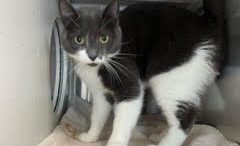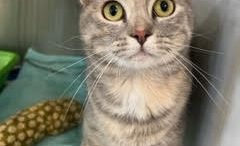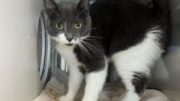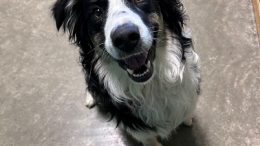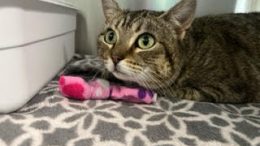
The Easter Bunny will be on hand for pet photo from 1 to 4 p.m. Saturday, March 12, during the Clarion PUPS’ Easter Extravaganza.
Pet owners and residents can hop on over to the Park Inn by Radisson in Clarion from 9 a.m. to 5 p.m. Saturday, March 12, for the Clarion PUPS’ Easter Extravaganza.
People may take their pooches to this dog-friendly event.
The fundraiser features vendors with a variety of items, a bake sale and a Chinese auction.
A rabies clinic will be held from 2 to 4 p.m. Rabies shots are $10. Dog licenses will available for purchase during the event.
New this year, Clarion PUPS will be doing doggy paw prints from 1 to 4 p.m. Pet pictures with the Easter Bunny will be taken from 1 to 4 p.m.
PUPS member Tiea Wolbert said this is one of the group’s major fundraisers for the year.
Clarion PUPS is a nonprofit organization that helps stay dogs in Clarion. Its mission statement is to utilize approved foster homes to act as a rescue network kennel, reuniting lost dogs and their owners or to seek new loving homes for displaced dogs. The organization also runs a dog food pantry.
The group provides temporary shelter, food/water, medical care, and abundant love to needy dogs while creating a positive community image by providing guidance and education to citizens of the community.
The group wishes to incorporate a dog park into its program and make it a community asset.
More information is available on the group’s Facebook page or online at clarionpups.com.
Clarion PUPS is hoping you can help Skipper find a first mate. This young Doxie mix male is up for adoption. He is crate trained and potty trained. He is a sweet and playful dog. More information about Skipper is available on the group’s Facebook page or by calling (814) 764-5580.
Make it Snappy
Snappy, a domestic medium hair, is a 2 to 4 year old neutered male. He has a broad head, large pointed ears, green eyes, and an orange and cream coat. Snappy is active, likes to be petted but doesn’t demand  attention. He likes to explore and is currently looking to upgrade his accommodations. You can help Snappy out with that when you take him home from the Venango County Humane Society, open from noon to 5 p.m., Mondays through Saturdays.
attention. He likes to explore and is currently looking to upgrade his accommodations. You can help Snappy out with that when you take him home from the Venango County Humane Society, open from noon to 5 p.m., Mondays through Saturdays.
All animals adopted from the shelter are spayed or neutered.
The humane society is located at 286 S. Main St. in Seneca.
More information is available by calling 814-677-4040 or online at venangocountyhumanesociety.org
It’s truly Hog Heaven
Hog Heaven Rescue Farm, located in Cochranton, began in 1998 and was incorporated and established as a not-for-profit registered 501c3 hoofed animal rescue in 2000. This rescue is a longtime dream come true for the founders, Regina Martin Allman and David Allman. 
The mission of Hog Heaven Rescue Farm is to rescue, rehabilitate and foster abused, neglected and unwanted hoofed animals. The rescue takes these animals in and provides veterinary care, feed and farrier care. It works on getting these animals healthy, physically, emotionally and socially. Then adopt them out to loving forever homes.
The farm operates on the funds provided by the co-founders as well as from increasingly generous community donations.
David Allman and Regina Martin are both retired Pittsburgh police officers that opted for a life in the country.
Hog Heaven urges people to do their research prior to buying a potbelly as there are no such things as mini or teacup. There are many sites online regarding this subject. If you are considering a potbelly pig as a family member, adopt don’t shop … check out the rescues that have them and adopt.
Regina Martin is Precious Paw’s volunteer Humane Society Police Officer for Venango County.
She can be reached at (814) 673-6485. More information about Hog Heaven can be found online at hogheavenrescue.org.
Talking dogs: Methods can help take the fear of vet visits for pets
Many animal lovers across the nation know exactly who Dr. Marty Becker, DVM, is. An author of more than 20 pet-related books, the resident veterinary contributor on “Good Morning America” for 17 years, the chief veterinary correspondent on Animal Radio and, well, I could go on and on. Becker has spent his life caring for pets and their people.
In 2014, Becker spearheaded and launched the “Fear Free” initiative, dedicated to practicing veterinary medicine with a focus on calm, low-stress environments and practices to encourage better health care and happier clients and staff.
“Simply put,” Becker said, “you have to take a pet’s emotional well-being in one hand and physical well-being in the other.”
According to “Bayer Veterinary Care Usage Study III: Feline Findings,” more than 50 percent of cat owners report that taking their cats in for veterinary care is stressful for their pets and themselves. This alone is a reason veterinary visits for cats are down. One aspect Fear Free focuses on is involving pet owners in a multi-modal approach, to ensure that just getting to the veterinarian’s office is as low stress as possible. The use of calming pheromone sprays on cat carriers or a bandanna that can be placed around your dog’s neck is one approach, as is prescribing some anti-anxiety medication for your pet to take before he leaves home.
Another way to aid your pet through any potentially uncomfortable experience is to pair it with high-in-value treats. Becker advises pet owners to bring their pet’s favorite treats with them, and to bring them in for their appointment hungry (unless medically contraindicated), so the pet is more likely to take treats offered during a visit. He also recommends that fearful pets be allowed to go directly into an exam room instead of waiting in the lobby, and he suggests that lobbies have plenty of visual barriers such as plants or shelves, to give owners the ability to somewhat shelter their pets from the curious eyes of others. Placing your cat carrier on a shelf prevents every dog that’s passing by being able to stare at or sniff at your feline.
It’s important to recognize that when pets are frightened and under stress, they behave in ways that are often labeled as “bad,” when the behavior is simply a natural response to fear. Dr. Karen Overall, DVM, Ph.D., extensively studies what fear, anxiety and stress do to our pets.
“Once a pet has been frightened, it never forgets the experience,” she said, increasing the likelihood that future veterinary visits will be even more stressful.
“Always start by looking after the pet’s emotional well-being,” Becker said. “Only after you’re confident the pet is calm or you’ve administered a sedative that has taken effect should you continue your exam or procedure. That is, first look after the pet’s emotional well-being and then its physical well-being.”
(Readers may contact Lisa Moore in care of LifeStyles, The Modesto Bee, P.O. Box 5256, Modesto, CA 95352.)
Blind cat captures hearts, leaves behind smiles
CARRBORO, N.C. (TNS) — Clients of the Charles House at Winmore sat a little straighter, hands folded in their laps and some smiling broadly, as Toby the Silver Tiger walked in the room.

Toby, a 6-month-old blind cat waits for passers-by to interact with in the lobby of the Charles House Elder Care Services Center in Chapel Hill, North Carolina. (AP)
“To-by! Toby the Tiger,” one woman sang, clapping her hands in time.
The black and silver-striped cat sniffed out his surroundings, rubbing against shoes and chair legs. He stopped, turning his head to listen with each new sound.
Owner Charlene Hayes wadded a piece of paper and tossed it across the floor. Toby poked his paws forward, kicking it around while the residents laughed, some reaching down to run a hand over his fur as he darted under the chairs.
“Cats. They’re just so clever,” said Fred Heinzel, who visits Charles House every day. He’s got two black cats — Ben and Jerry — at home who love to chase each other. It’s nice when Toby stops by the Charles House, he said.
The cat, now 10 months old, has found a forever family with Hayes and a growing career as a companion for older adults with dementia and other health issues. His “play dates” regularly take him to Charles House and other senior communities.
Toby is “curious and affectionate,” family friend Carla Shuford said. “It’s the perfect combination for a therapy cat.”
He’s also blind.
Shuford connected Hayes, a therapy-dog foster parent and former animal clinic employee, with Toby last year after learning that the then-12 week old cat was available for adoption from the Independent Animal Rescue group.
The family had to act fast, Hayes said. They picked up Toby on Saturday and, by Sunday, were packed into a car with three cats for the 33-hour drive west to their summer home in Mexico. Hayes’s other cats Rikki Tikki Tavi, 8, and Alli Bali G, 15, also are blind.
Cats can be born or go blind for many reasons, from heredity to trauma, diet and disease. Toby’s eyes were underdeveloped, causing his eyelids and lashes to turn under. He had surgery in December to close them, reducing the chance of irritation and infection, Hayes said.
Blind cats don’t know they’re blind, so life for Toby is fairly typical, she said. He perches in the window, listening to the winds and birds. He rolls around in the flowers and sharpens his claws on pieces of wood. He plays with his brothers, especially hide-and-seek, she said.
“They would run in the bedroom and jump on the bed and not move,” she said. “As soon as he would walk in the room, he would smell the air and jump on the bed, like, OK, I found you. So it is pretty amazing what other senses come forward to make up for the eyesight loss.”
Navigating a new space is simple once Toby learns the layout, she said. He’s learned to use the stairs — he backs down like a toddler, she said — and jump between objects and to the floor. Hayes taps her finger where she wants him to go. He wears a leash outside.
“When he’s running full speed, he doesn’t know any parameters,” she said. “He could fall into the pool, he has run into a tree, so we’re just trying to make sure that he’s going to be safe.”
Noisy toys are great, Hayes said, but she’s also teaching residents to go “fishing” for Toby by snapping ribbons in the air and pulling them across the floor. They cheered when Toby snagged his claw on the ribbon, wrestling it to the floor.
“It’s all about entertainment for them, but it’s also for them to have the hands-on (experience), touching the fur,” she said. “If he hasn’t made his rounds, before we leave, I pick him up and make sure everybody has some fur time.”
Toby visits for 30 minutes to an hour, sitting by the front door when he’s ready to go. Staff members have started to let them know when someone having a rough day might need more attention, Hayes said. The visits have inspired at least one resident to rethink staying in bed all day, she said.
“Sometimes it makes a big difference to have something to look forward to,” Hayes said.
(All About Animals is a weekly blog that appears on Venangoextra.com and Clarionextra.com. Interested persons or groups can submit information to bigdogs.thederrick@gmail.com. More information about the blog is available by contacting Anna Applegate at 814-677-8364.)


